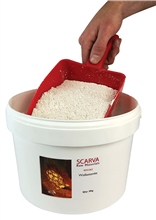Valerio
de
Italy
asks
Are your oxides/carbonates/other salts in your raw material section pure products? Are there additives? I need the pure substances.
|
Réponses de Scarva:
|
These are all pure raw materials or oxides there are no substitutes or additives.
|
Carrie
de
United Kingdom
asks
I’m looking for copper oxide to make into a watercolour paint - i have been making my own by oxidising old copper pipes but now need a larger quantity- is this just pure copper Oxide ( verdigris) or does it have anything else in it ?
|
Réponses de Scarva:
|
This is copper carbonate here is a link to copper oxide:
https://www.scarva.com/en/Scarva-Raw-Materials-Copper-Oxide-RM1306/m-166.aspx
|
Midge
de
United Kingdom
asks
This has been purchased for me, I’d like to use it to paint on top of the stoneware tin glaze. How should it be used / mixed to achieve a majolica look?
Thank you
|
Réponses de Scarva:
|
Hi, if you were to combine 50g of copper carbonate to 50g of our brush on medium RM1072 that would create a wash you could use. Hope this helps.
|
Lynsey
de
United Kingdom
asks
Hi I would like some more information on this product. Do you have any examples of what this looks like when fired. How is it used?
Is there a visual example of all your oxides once fired, just like your glazes. What temperature do you recomend oxides be fired at? Can they be fired at the same time as a glaze?
|
Réponses de Scarva:
|
Copper Carbonate is used to colour clay bodies, glazes or use as a raw oxide on work. To colour a glaze use between 3-7%. Colour of glaze will vary depending on base raw materials but it will produce mostly green.
When using as a raw oxide to colour clay apply to bisque ware then wash off excess with a sponge. Suitable protective gloves and mask should be worn when applying then fire to at least 1200oC in the kiln. Oxides may be fired along side glazed ware however it is important to note that certain oxides when placed to closely to glazed ware may discolour the glaze so leave a generous space between vessels.
|

































